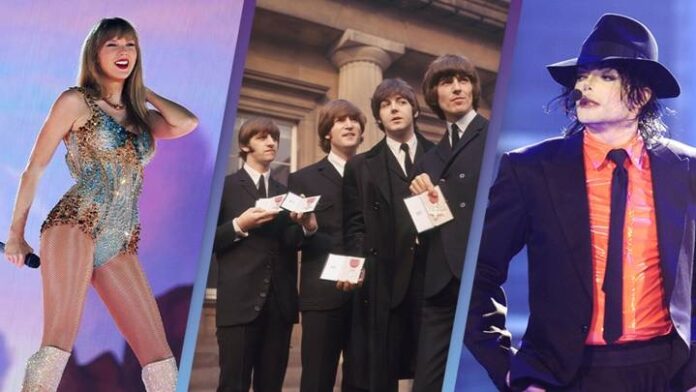By Glenda Mauro
The origins of pop music can be traced back to the early 20th century, with influences from various musical styles, including jazz, blues, and country. The term “pop” is short for “popular” and refers to music that appeals to a wide audience. Pop music as we know it today began to take shape in the 1950s, with the rise of artists such as Elvis Presley, Chuck Berry, and Little Richard, who brought elements of rhythm and blues to a mainstream audience. Their energetic performances and catchy tunes helped establish the foundations of pop music.
During the 1960s, the British Invasion brought bands like The Beatles and The Rolling Stones to the forefront of popular music, influencing a generation and shaping the sound of pop for years to come. The fusion of rock and roll with catchy melodies and relatable lyrics became a hallmark of the genre. As the 1970s arrived, pop music continued to diversify, incorporating elements of disco, funk, and soul. This era saw the emergence of iconic acts like ABBA, whose infectious pop melodies dominated the airwaves, and the Bee Gees, whose disco hits became synonymous with the era. The disco movement, with its upbeat rhythms and danceable tunes, brought a new dimension to pop music and set the stage for the dance-oriented sound of the late 1970s.
The 1980s was a decade of innovation and experimentation in pop music. The introduction of MTV and the rise of music videos transformed the industry, allowing artists to showcase their creativity visually. The era produced enduring pop icons such as Michael Jackson, whose groundbreaking album “Thriller” became the best-selling album of all time, and Madonna, who redefined the concept of the pop superstar with her boundary-pushing music and provocative imagery. The 1990s witnessed a diverse array of pop music, from the resurgence of boy bands like NSYNC and the Backstreet Boys to the emergence of the powerful female artists like Britney Spears. The decade also saw the rise of alternative and grunge music, which influenced the pop landscape with a raw and edgy sound, exemplified by artists like Nirvana and early 20th centuries, with the emergence of Pearl Jam.
With its lively rhythms and improvisational nature, in recent years, pop music has continued to evolve, embracing influences from captivated audiences and setting the stage for hip-hop, electronic dance music, and indie rock. Artists such as Taylor Swift, Ariana Grande, and Billie Eilish have pushed the boundaries of the lyrics and genre, soulfully incorporating personal melodies, storytelling, and innovative production techniques into their music’s crucial role in shaping the pop landscape.
Today, pop music remains a dominant force in the music industry, with artists from around the world pushing boundaries and experimenting with new sounds while staying true to the genre’s core elements of catchy melodies, relatable lyrics, and broad appeal. Streaming platforms such as Spotify, Apple Music, and YouTube have revolutionized the way people discover and listen to music. The ease of access to a vast library of songs has democratized the industry, providing a platform for emerging artists to share their music globally without the need for traditional record labels. This shift has encouraged a more diverse range of voices and sounds to emerge within the pop music landscape, enriching the genre with fresh perspectives and innovative approaches.
Collaborations have also become a defining feature of modern pop music, with artists from different genres coming together to create unique and boundary-pushing tracks. These collaborations not only showcase the versatility of pop music but also blur the lines between genres, resulting in a more fluid and dynamic musical landscape.
Furthermore, the themes explored in contemporary pop music reflect the experiences and emotions of a diverse and global audience. From songs addressing mental health and social justice issues to tracks celebrating empowerment and self-love, pop music has become a platform for artists to express their authenticity and connect with listeners on a deeper level. As we move forward, the future of pop music is likely to continue embracing innovation, diversity, and inclusivity. With technology evolving at a rapid pace and the music industry constantly shifting, pop music will undoubtedly remain a powerful force in shaping popular culture and resonating with audiences around the world.
Throughout its history, pop music has reflected the cultural and social changes of each era, serving as a mirror to the hopes, dreams, and challenges of society. From its humble beginnings to its present-day global influence, pop music continues to shape and define popular culture, resonating with audiences around the world. Technology has played a pivotal role in shaping the direction of pop music. The rise of social media platforms like Instagram, TikTok, and Twitter has transformed how artists engage with their fans, promote their music, and even create new trends. This direct connection between artists and their audience has led to a more interactive and intimate relationship, influencing the creative process and the way music is consumed.

